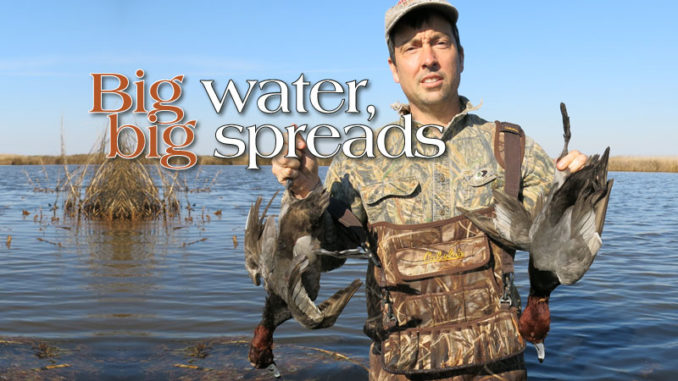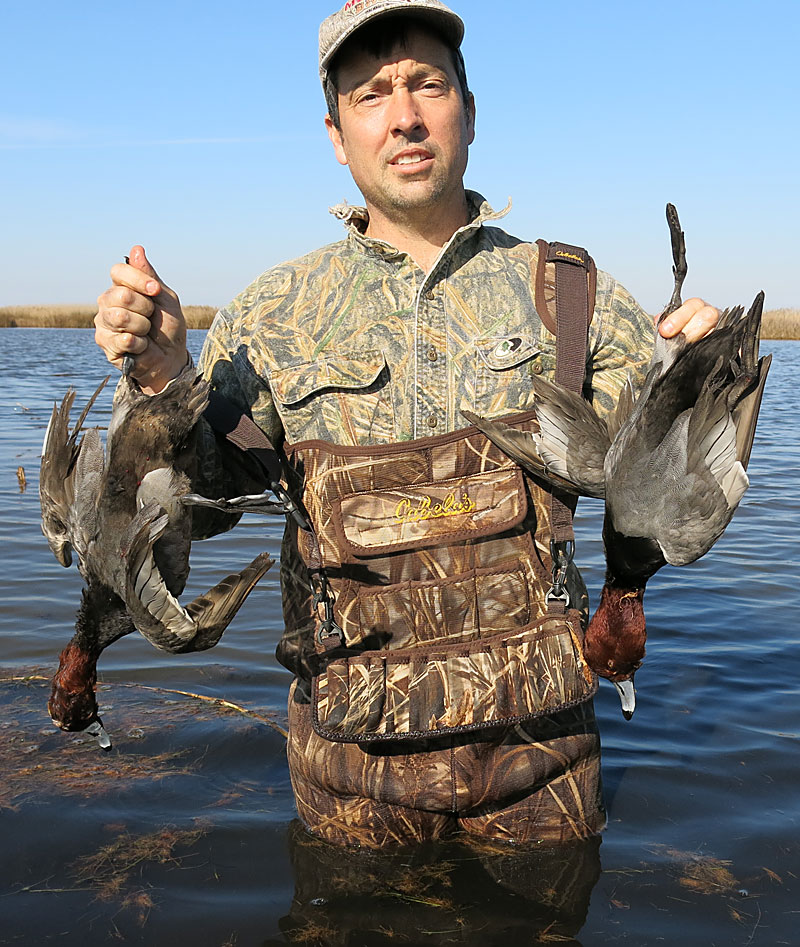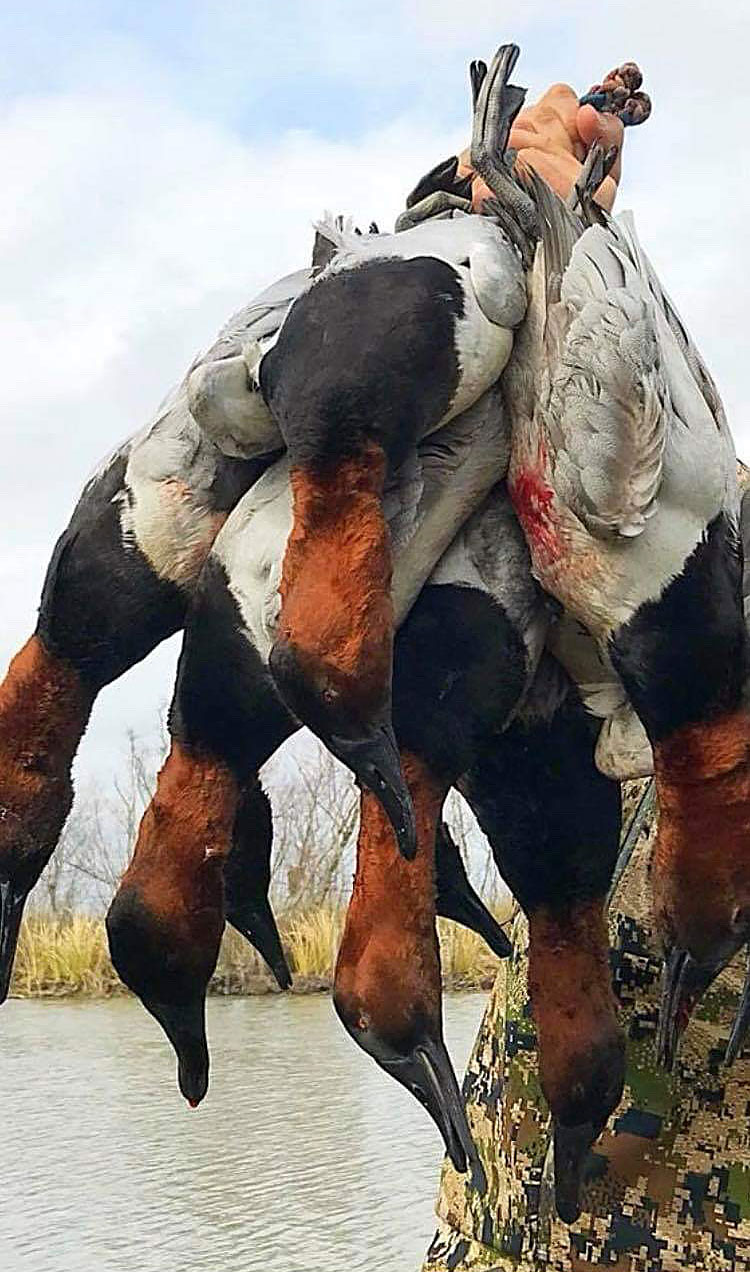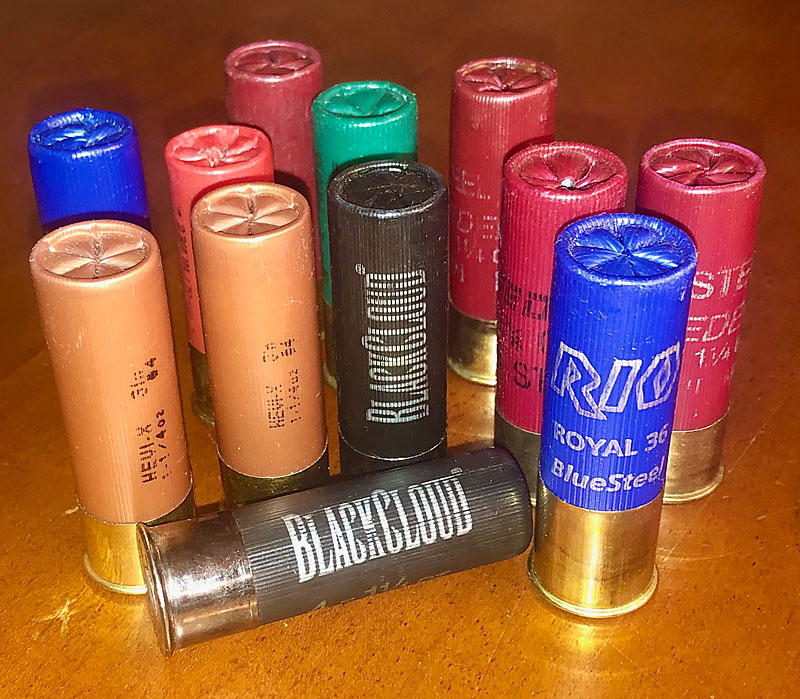
Hundreds of decoys are what’s needed to fool diving ducks on big waters like North Carolina’s Roanoke Rapids Lake, where canvasbacks are still king.
Every year, the brief, early duck seasons are merely teasers for Carolina waterfowlers. They afford a few shooting rallies for hunters set up in the right spots. It’s December when most of the northern flocks arrive within the states’ borders. That’s when a proper decoy spread is most important.
Birds funnel into places decked out with a rich food source. These migrants are typically looking for the security of other feathered friends rafted together. Duck hunters with the right decoy spreads can bamboozle these incoming flocks into shotgun range.
Most types of hunting often require specialized gear. Of all the available species in the Carolinas, ducks ranks in the top tier for needed gear, especially in open-water situations. Hunters can stand right along the run of a beaver swamp and take a few pass shots at dawn. But serious duck-hunting on open water requires a significant gear investment to consistently lure winged visitors into shotgun range.

Guide Darrell Mcauly of Carolina Waterfowler Guide Service knows what a massive investment is all about. But it’s all the decoys he’s bought that go in his huge spread that brings the birds in on a string.
“I use 1,500 Herters decoys each year, divided into three spreads, at our three blinds on Roanoke Rapids Lake,” said Mcauly (910-263-3499), who is from Hope Mills, N.C. “I love the Herters decoys because they sit up high on the water.”
Make your decoys mimic what the local birds do
Mcauly’s decoy spreads mimic what the birds are expecting to see on his home territory.
“We winter around 15,000 to 20,000 canvasbacks each year, as well as ring necks and some other species,” he said. “These birds raft up in the middle of the lake and then break off into small groups to go to feed. They don’t all come at one time. They come in small groups between five to 15 birds.”

After daylight, ducks move off the main body of the lake, the furthest downstream on the Roanoke River system, and head to feeding areas along the points and places where a winter food source is available. According to Mcauly, mussel beds are the primary food source for divers.
“I know where the mussel beds are on the lake. I set up 350 to 400 decoys right on top of these mussel beds,” he said.
Mcauly’s hunters routinely take home a mixed bag of ducks. But the primary species on Roanoke Rapids Lake are canvasbacks and other diving ducks. Divers’ chief survival mechanism is safety in numbers. So a large spread of decoys right on top of a rich food source is a deadly tactic.
Mcauly’s decoy spread is made up primarily of canvasbacks. But he adds ring necks and any other divers with large white patches that stand out from afar.
Demonstrate a feeding area with your dekes

“It’s a numbers game, and you need a large spread of decoys in the right places to get these birds to come in,” he said. “I make it look like a feeding area by placing the decoys close together on the flats.”
Bringing the birds to the right area is the first half of the deal. But with a large spread, ducks can land in a wide variety of places, sometimes out of shooting range if not set up correctly. Mcauly uses a duck’s natural instincts to funnel the birds to within shotgun range.
“I run my decoy spread in pods, with one line out each side of the blind, and then start one out the middle about 20 yards out, leaving two runways on either side,” he said. “I leave an opening in the center and then put out about 30 decoys as blockers. The ducks don’t like to fly over other birds, and they will land right in the runways (in front of) the blockers, well within range.”
Mcauly also sets up most of his spread to the west of his blind, so that the sun is to his back. While a cloudy, overcast day is always preferred, some days, the sun is out and bright. Having it at the hunters’ backs reduces glare, makes it easier for hunters to shoot without looking into the sun, and it reduces visibility for the incoming ducks.
Be prepared to make adjustments to your decoy spread
“We get a steady stream of ducks coming off the big water for an hour-and-a-half,” he said. “They are looking to find the rest of the flock on one of the mussel flats.”
Ducks don’t leave their rafts and come all at once. And that gives hunters the chance to adjust their spreads if the birds are landing out of reasonable shotgun range. A few adjustments to open a closer lane is sometimes all that hunters need to get them into killing range.
In addition to divers, Mcauly also takes his fair share of puddle ducks in his diver spreads. The large spread brings in ducks of all species, but to sweeten the pot, he will utilize some puddle duck decoys.
“We will use some puddle ducks in the lanes, too, when we have puddle ducks around,” he said.
Naturally, puddle ducks will be attracted to other ducks, especially when rafted up on a known food source. As long as the water isn’t too deep, they will stay and feed on any available food and from green forage that divers dredge up off the bottom.
“Widgeon are often called robbers, because they will still grass right out of a diver’s mouth,” he said.
The remaining 40 or so days of the waterfowl season arrive this month, and hunters will be scattered throughout every swamp, beaver pond, salt marsh, and lake across the state after a six-pack of ducky goodness. While duck hunters will use everything in the duck hunter’s playbook, the decoy fleet alone will produce the greatest impact on the day’s successes.
Carolinas’ duck seasons
South Carolina
Dec. 12-Jan. 31, 2020
North Carolina
Nov. 16-Dec. 2, Dec. 14-Jan. 31, 2020
Consider premium waterfowl loads
In 1991, the U.S. Fish and Wildlife Service banned the use of lead shot for hunting waterfowl after studies showed that nearly 2 million birds died each year from ingesting the toxic material.
For the next decade, steel shot was the immediate replacement, and it still reigns as the most-popular waterfowl load, despite a lower shot-to-kill ratio compared to lead.
Over the past 20 years, waterfowl loads have significantly improved, with high-tech metal alloys and engineered wadding configurations to provide ballistics and knockdown power similar to traditional lead shot shells. Premium shells feature tungsten, bismuth and even a new alloy called ITX made by Backridge, a Tennessee company.

These alternative metal alloys offer a denser material and pliability to provide knockdown power comparable to lead. Backridge’s ITX-13 is famed to be denser than lead. Federal Black Cloud TSS — Tungsten Super Shot — is a tungsten load that is denser than lead, with a configuration with a mixture of heavyweight TSS pellets and irregularly shaped steel pellets. The different types of shot concert to cause catastrophic damage to its intended winged targets.
Cut down on cripples
Besides Federal, RIO and Kent, virtually every manufacturer has developed a non-toxic waterfowl load utilizing bismuth, tungsten or a steel variant to produce a shell with power to bring down birds. The technologically advanced waterfowl loads are more effective at killing than traditional steel shot, leading to fewer cripples and fly-offs.
However, the trade-off comes with the cost. Traditional steel shot is roughly 21/2 times more expensive than lead, and the high-tech alloys bring a much-higher price tag than the steel shot. What should a hunter do? Is it worth spending the extra money on premium shells?
For most hunters in most situations, a box of 25 shells is more than enough to knock down a limit of six ducks. Except for a few above-average days, hunters typically only get a handful of shot opportunities, anyway After spending a small fortune on decoys, gas, duck boats, blinds, waders, hunting leases, shotguns and other gear, choosing lower-quality shot shells is a bad place to reduce costs and save money. Hunters will be more efficient by shooting fewer times for the same bag.
Technological advances in non-toxic waterfowl loads have given hunters an extreme advantage over their prey. Consider using high-quality shells for waterfowl this season, and put more birds on the ground, more quickly and with fewer shots.




Be the first to comment